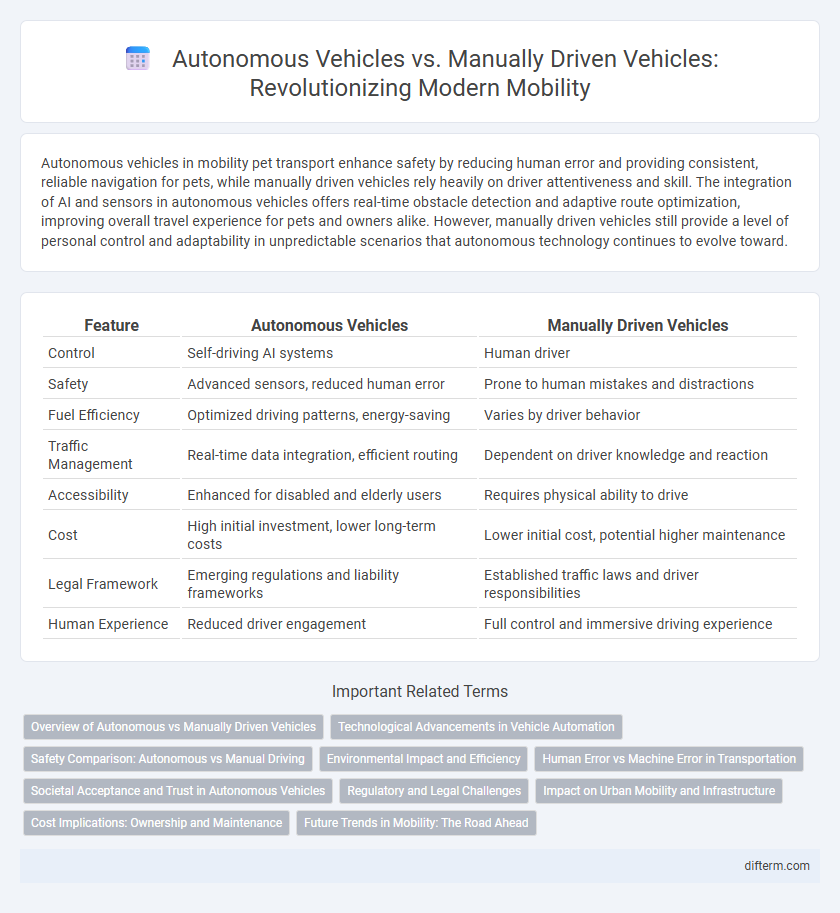Autonomous vehicles in mobility pet transport enhance safety by reducing human error and providing consistent, reliable navigation for pets, while manually driven vehicles rely heavily on driver attentiveness and skill. The integration of AI and sensors in autonomous vehicles offers real-time obstacle detection and adaptive route optimization, improving overall travel experience for pets and owners alike. However, manually driven vehicles still provide a level of personal control and adaptability in unpredictable scenarios that autonomous technology continues to evolve toward.
Table of Comparison
| Feature | Autonomous Vehicles | Manually Driven Vehicles |
|---|---|---|
| Control | Self-driving AI systems | Human driver |
| Safety | Advanced sensors, reduced human error | Prone to human mistakes and distractions |
| Fuel Efficiency | Optimized driving patterns, energy-saving | Varies by driver behavior |
| Traffic Management | Real-time data integration, efficient routing | Dependent on driver knowledge and reaction |
| Accessibility | Enhanced for disabled and elderly users | Requires physical ability to drive |
| Cost | High initial investment, lower long-term costs | Lower initial cost, potential higher maintenance |
| Legal Framework | Emerging regulations and liability frameworks | Established traffic laws and driver responsibilities |
| Human Experience | Reduced driver engagement | Full control and immersive driving experience |
Overview of Autonomous vs Manually Driven Vehicles
Autonomous vehicles utilize advanced sensors, machine learning algorithms, and real-time data processing to navigate and control driving functions without human intervention, enhancing safety and efficiency. Manually driven vehicles rely on human drivers for decision-making and control, which introduces variability and potential for human error. The shift towards autonomous technology aims to reduce traffic accidents and improve traffic flow, while manual vehicles remain prevalent due to current regulatory, ethical, and infrastructural challenges.
Technological Advancements in Vehicle Automation
Technological advancements in vehicle automation have led to the integration of sophisticated sensors, artificial intelligence, and machine learning algorithms in autonomous vehicles, enhancing their ability to navigate complex traffic environments with high precision. Autonomous vehicles utilize LIDAR, radar, and computer vision to interpret real-time data, significantly reducing human error compared to manually driven vehicles. Continuous improvements in vehicle-to-everything (V2X) communication further optimize traffic flow and safety, positioning autonomous mobility as a transformative shift in transportation technology.
Safety Comparison: Autonomous vs Manual Driving
Autonomous vehicles utilize advanced sensors, machine learning algorithms, and real-time data processing to significantly reduce human error, the leading cause of over 90% of traffic accidents. Studies show that self-driving cars can potentially lower collision rates by up to 80% compared to manually driven vehicles, particularly in complex urban environments. However, safety challenges remain in handling unpredictable scenarios, system malfunctions, and cybersecurity threats inherent to autonomous systems.
Environmental Impact and Efficiency
Autonomous vehicles optimize fuel consumption and reduce emissions through precise control and efficient routing, outperforming manually driven cars in lowering environmental impact. Advanced sensors and AI enable smoother acceleration and braking, decreasing energy waste and promoting sustainable mobility. Data-driven traffic management further enhances efficiency by minimizing congestion and emissions in urban areas.
Human Error vs Machine Error in Transportation
Autonomous vehicles significantly reduce human error, which accounts for over 90% of traffic accidents globally, by relying on advanced sensors and AI algorithms for real-time decision making. However, machine errors in autonomous systems, such as software glitches or sensor malfunctions, still pose safety risks, though their incidence is statistically lower than driver-related mistakes. Continuous improvements in machine learning and sensor integration aim to minimize these errors, making autonomous transportation safer and more reliable than manually driven vehicles.
Societal Acceptance and Trust in Autonomous Vehicles
Societal acceptance of autonomous vehicles hinges on public trust in their safety, reliability, and ethical decision-making capabilities compared to manually driven vehicles. Studies reveal that transparent communication about autonomous vehicle technology and rigorous regulatory standards significantly enhance user confidence and willingness to adopt self-driving cars. Trust-building initiatives, such as real-world testing demonstrations and clear accident liability frameworks, are critical to overcoming skepticism and accelerating autonomous mobility integration.
Regulatory and Legal Challenges
Autonomous vehicles face complex regulatory and legal challenges including liability determination, data privacy concerns, and compliance with evolving safety standards. Manual vehicles operate within established legal frameworks, whereas autonomous systems require new laws addressing software failures and cybersecurity risks. Governments worldwide are actively developing policies to balance innovation with public safety and accountability in the deployment of self-driving cars.
Impact on Urban Mobility and Infrastructure
Autonomous vehicles significantly reshape urban mobility by reducing traffic congestion and optimizing road usage through advanced sensor technology and real-time data analysis. They demand upgraded infrastructure, including smart traffic signals, dedicated lanes, and enhanced connectivity networks to support vehicle-to-infrastructure communication. Compared to manually driven vehicles, autonomous systems improve safety, lower emissions, and transform urban planning by enabling more efficient land use and parking solutions.
Cost Implications: Ownership and Maintenance
Autonomous vehicles generally incur higher upfront costs due to advanced sensors, AI systems, and specialized components, while manually driven vehicles remain less expensive to purchase. Maintenance for autonomous vehicles often requires specialized technicians and software updates, increasing service expenses compared to traditional vehicles that rely on standard mechanical repairs. Over time, however, autonomous vehicles can reduce operational costs through optimized driving patterns, lower fuel consumption, and decreased accident-related repairs.
Future Trends in Mobility: The Road Ahead
Autonomous vehicles leverage advanced AI, lidar, and sensor fusion technologies to enhance safety, reduce traffic congestion, and optimize energy efficiency compared to manually driven vehicles. Future trends indicate widespread adoption of vehicle-to-everything (V2X) communication, enabling real-time data exchange for coordinated traffic management and improved urban mobility. Integration of autonomous systems with smart city infrastructure is expected to revolutionize transportation networks by 2035, driving sustainable and efficient mobility solutions.
autonomous vehicles vs manually driven vehicles Infographic

 difterm.com
difterm.com